Effects of Modifying Thioflavin T at the N3-Position on Its G4 Binding and Fluorescence Emission
Abstract
:1. Introduction
2. Results
2.1. Fluorescence Spectral Analysis of ThT, ThT-HE, and ThT-AE
2.2. Fluorescence Spectral Analysis of ThT-OE2, ThT-SP, and ThT-OE11
2.3. Binding Affinity and UV–Vis Spectral Analysis
3. Discussion
4. Materials and Methods
4.1. Materials
4.2. Chemical Syntheses of ThT Derivatives
4.3. Fluorescence Spectral Analysis
5. Conclusions
Supplementary Materials
Author Contributions
Funding
Conflicts of Interest
References
- Liu, L.; Shao, Y.; Peng, J.; Huang, C.; Liu, H.; Zhang, L. Molecular Rotor-Based Fluorescent Probe for Selective Recognition of Hybrid G-Quadruplex and as a K+ Sensor. Anal. Chem. 2014, 86, 1622–1631. [Google Scholar] [CrossRef] [PubMed]
- Yaku, H.; Fujimoto, T.; Murashima, T.; Miyoshi, D.; Sugimoto, N. Phthalocyanines: A new class of G-quadruplex-ligands with many potential applications. Chem. Commun. 2012, 48, 6203–6216. [Google Scholar] [CrossRef] [PubMed]
- Endoh, T.; Sugimoto, N. Conformational Dynamics of the RNA G-Quadruplex and its Effect on Translation Efficiency. Molecules 2019, 24, 1613. [Google Scholar] [CrossRef] [PubMed] [Green Version]
- Rhodes, D.; Lipps, H.J. G-quadruplexes and their regulatory roles in biology. Nucleic Acids Res. 2015, 43, 8627–8637. [Google Scholar] [CrossRef] [Green Version]
- Dhamodharan, V.; Pradeepkumar, P.I. Specific Recognition of Promoter G-Quadruplex DNAs by Small Molecule Ligands and Light-up Probes. ACS Chem. Biol. 2019, 14, 2102–2114. [Google Scholar] [CrossRef]
- Ruggiero, E.; Richter, S.N. G-quadruplexes and G-quadruplex ligands: Targets and tools in antiviral therapy. Nucleic Acids Res. 2018, 46, 3270–3283. [Google Scholar] [CrossRef]
- Rosenberg, J.E.; Bambury, R.M.; Van Allen, E.M.; Drabkin, H.A.; Lara, P.N., Jr.; Harzstark, A.L.; Wagle, N.; Figlin, R.A.; Smith, G.W.; Garraway, L.A.; et al. A phase II trial of AS1411 (a novel nucleolin-targeted DNA aptamer) in metastatic renal cell carcinoma. Investig. New Drugs 2014, 32, 178–187. [Google Scholar] [CrossRef]
- Biffi, G.; Tannahill, D.; McCafferty, J.; Balasubramanian, S. Quantitative visualization of DNA G-quadruplex structures in human cells. Nat. Chem. 2013, 5, 182–186. [Google Scholar] [CrossRef] [PubMed]
- Vummidi, B.R.; Alzeer, J.; Luedtke, N.W. Fluorescent Probes for G-Quadruplex Structures. Chem. Biol. Chem. 2013, 14, 540–558. [Google Scholar] [CrossRef]
- Mohanty, J.; Barooah, N.; Dhamodharan, V.; Harikrishna, S.; Pradeepkumar, P.I.; Bhasikuttan, A.C. Thioflavin T as an Efficient Inducer and Selective Fluorescent Sensor for the Human Telomeric G-Quadruplex DNA. J. Am. Chem. Soc. 2013, 135, 367–376. [Google Scholar] [CrossRef]
- Freire, S.; de Araujo, M.H.; Al-Soufi, W.; Novo, M. Photophysical study of Thioflavin T as fluorescence marker of amyloid fibrils. Dyes Pigments 2014, 110, 97–105. [Google Scholar] [CrossRef]
- Sulatskaya, A.I.; Maskevich, A.A.; Kuznetsova, I.M.; Uversky, V.N.; Turoverov, K.K. Fluorescence Quantum Yield of Thioflavin T in Rigid Isotropic Solution and Incorporated into the Amyloid Fibrils. PLoS ONE 2010, 5, e15385. [Google Scholar] [CrossRef] [Green Version]
- Stsiapura, V.I.; Maskevich, A.A.; Tikhomirov, S.A.; Buganov, O.V. Charge Transfer Process Determines Ultrafast Excited State Deactivation of Thioflavin T in Low-Viscosity Solvents. J. Phys. Chem. A 2010, 114, 8345–8350. [Google Scholar] [CrossRef]
- Amdursky, N.; Erez, Y.; Huppert, D. Molecular Rotors: What Lies Behind the High Sensitivity of the Thioflavin-T Fluorescent Marker. Acc. Chem. Res. 2012, 45, 1548–1557. [Google Scholar] [CrossRef] [PubMed]
- Stsiapura, V.I.; Maskevich, A.A.; Kuzmitsky, V.A.; Turoverov, K.K.; Kuznetsova, I.M. Computational Study of Thioflavin T Torsional Relaxation in the Excited State. J. Phys. Chem. A 2007, 111, 4829–4835. [Google Scholar] [CrossRef]
- Sulatskaya, A.I.; Rychkov, G.N.; Sulatsky, M.I.; Rodina, N.P.; Kuznetsova, I.M.; Turoverov, K.K. Thioflavin T Interaction with Acetylcholinesterase: New Evidence of 1:1 Binding Stoichiometry Obtained with Samples Prepared by Equilibrium Microdialysis. ACS Chem. Neurosci. 2018, 9, 1793–1801. [Google Scholar] [CrossRef]
- Kataoka, Y.; Fujita, H.; Kasahara, Y.; Yoshihara, T.; Tobita, S.; Kuwahara, M. Minimal Thioflavin T Modifications Improve Visual Discrimination of Guanine-Quadruplex Topologies and Alter Compound-Induced Topological Structures. Anal. Chem. 2014, 86, 12078–12084. [Google Scholar] [CrossRef] [PubMed]
- Kataoka, Y.; Fujita, H.; Afanaseva, A.; Nagao, C.; Mizuguchi, K.; Kasahara, Y.; Obika, S.; Kuwahara, M. High-Contrast Facile Imaging with Target-Directing Fluorescent Molecular Rotors, the N 3-Modified Thioflavin T Derivatives. Biochemistry 2019, 58, 493–498. [Google Scholar] [CrossRef]
- Fujita, H.; Kataoka, Y.; Nagano, R.; Nakajima, Y.; Yamada, M.; Sugimoto, N.; Kuwahara, M. Specific Light-Up System for Protein and Metabolite Targets Triggered by Initiation Complex Formation. Sci. Rep. 2017, 7, 15191. [Google Scholar] [CrossRef]
- Fujita, H.; Kataoka, Y.; Tobita, S.; Kuwahara, M.; Sugimoto, N. Novel One-Tube-One-Step Real-Time Methodology for Rapid Transcriptomic Biomarker Detection: Signal Amplification by Ternary Initiation Complexes. Anal. Chem. 2016, 88, 7137–7144. [Google Scholar] [CrossRef]
- Guan, A.J.; Zhang, X.F.; Sun, X.; Li, Q.; Xiang, J.F.; Wang, L.X.; Lan, L.; Yang, F.M.; Xu, S.J.; Guo, X.M.; et al. Ethyl-substitutive Thioflavin T as a highly-specific fluorescence probe for detecting G-quadruplex structure. Sci. Rep. 2018, 8, 2666. [Google Scholar] [CrossRef]
- Yum, J.H.; Park, S.; Sugiyama, H. G-quadruplexes as versatile scaffolds for catalysis. Org. Biomol. Chem. 2019, 17, 9547–9561. [Google Scholar] [CrossRef] [PubMed]
- Zheng, K.W.; Chen, Z.; Hao, Y.H.; Tan, Z. Molecular crowding creates an essential environment for the formation of stable G-quadruplexes in long double-stranded DNA. Nucleic Acids Res. 2010, 38, 327–338. [Google Scholar] [CrossRef] [PubMed] [Green Version]
- Kang, H.; Yoo, J.; Sohn, B.K.; Lee, S.W.; Lee, H.S.; Ma, W.; Kee, J.M.; Aksimentiev, A.; Kim, H. Sequence-dependent DNA condensation as a driving force of DNA phase separation. Nucleic Acids Res. 2018, 46, 9401–9413. [Google Scholar] [CrossRef] [PubMed]
- Geall, A.J.; Taylor, R.J.; Earll, M.E.; Eaton, M.A.; Blagbrough, I.S. Synthesis of Cholesteryl Polyamine Carbamates: pKa Studies and Condensation of Calf Thymus DNA. Bioconjug. Chem. 2000, 11, 314–326. [Google Scholar] [CrossRef]
- Chen, B.J.; Wu, Y.L.; Tanaka, Y.; Zhang, W. Small Molecules Targeting c-Myc Oncogene: Promising Anti-Cancer Therapeutics. Int. J. Biol. Sci. 2014, 10, 1084–1096. [Google Scholar] [CrossRef]
- Dhamodharan, V.; Harikrishna, S.; Bhasikuttan, A.C.; Pradeepkumar, P.I. Topology Specific Stabilization of Promoter over Telomeric G-Quadruplex DNAs by Bisbenzimidazole Carboxamide Derivatives. ACS Chem. Biol. 2015, 10, 821–833. [Google Scholar] [CrossRef]
- Jin, M.; Liu, X.; Zhang, X.; Wang, L.; Bing, T.; Zhang, N.; Zhang, Y.; Shangguan, D. Thiazole Orange-Modified Carbon Dots for Ratiometric Fluorescence Detection of G-Quadruplex and Double-Stranded DNA. ACS Appl. Mater. Interfaces 2018, 10, 25166–25173. [Google Scholar] [CrossRef]
- Rodriguez, R.; Miller, K.M.; Forment, J.V.; Bradshaw, C.R.; Nikan, M.; Britton, S.; Oelschlaegel, T.; Xhemalce, B.; Balasubramanian, S.; Jackson, S.P. Small-molecule-induced DNA damage identifies alternative DNA structures in human genes. Nat. Chem. Biol. 2012, 8, 301–310. [Google Scholar] [CrossRef] [Green Version]
- Kang, H.J.; Park, H.J. Novel Molecular Mechanism for Actinomycin D Activity as an Oncogenic Promoter G-Quadruplex Binder. Biochemistry 2009, 48, 7392–7398. [Google Scholar] [CrossRef]
- Phan, A.T.; Kuryavyi, V.; Burge, S.; Neidle, S.; Patel, D.J. Structure of an Unprecedented G-Quadruplex Scaffold in the Human c-kit Promoter. J. Am. Chem. Soc. 2007, 129, 4386–4392. [Google Scholar] [CrossRef] [PubMed] [Green Version]
- Kumari, S.; Bugaut, A.; Huppert, J.L.; Balasubramanian, S. An RNA G-quadruplex in the 5′ UTR of the NRAS proto-oncogene modulates translation. Nat. Chem. Biol. 2007, 3, 218–221. [Google Scholar] [CrossRef] [PubMed] [Green Version]
- Dai, J.; Carver, M.; Punchihewa, C.; Jones, R.A.; Yang, D. Structure of the Hybrid-2 type intramolecular human telomeric G-quadruplex in K+ solution: Insights into structure polymorphism of the human telomeric sequence. Nucleic Acids Res. 2007, 35, 4927–4940. [Google Scholar] [CrossRef] [Green Version]

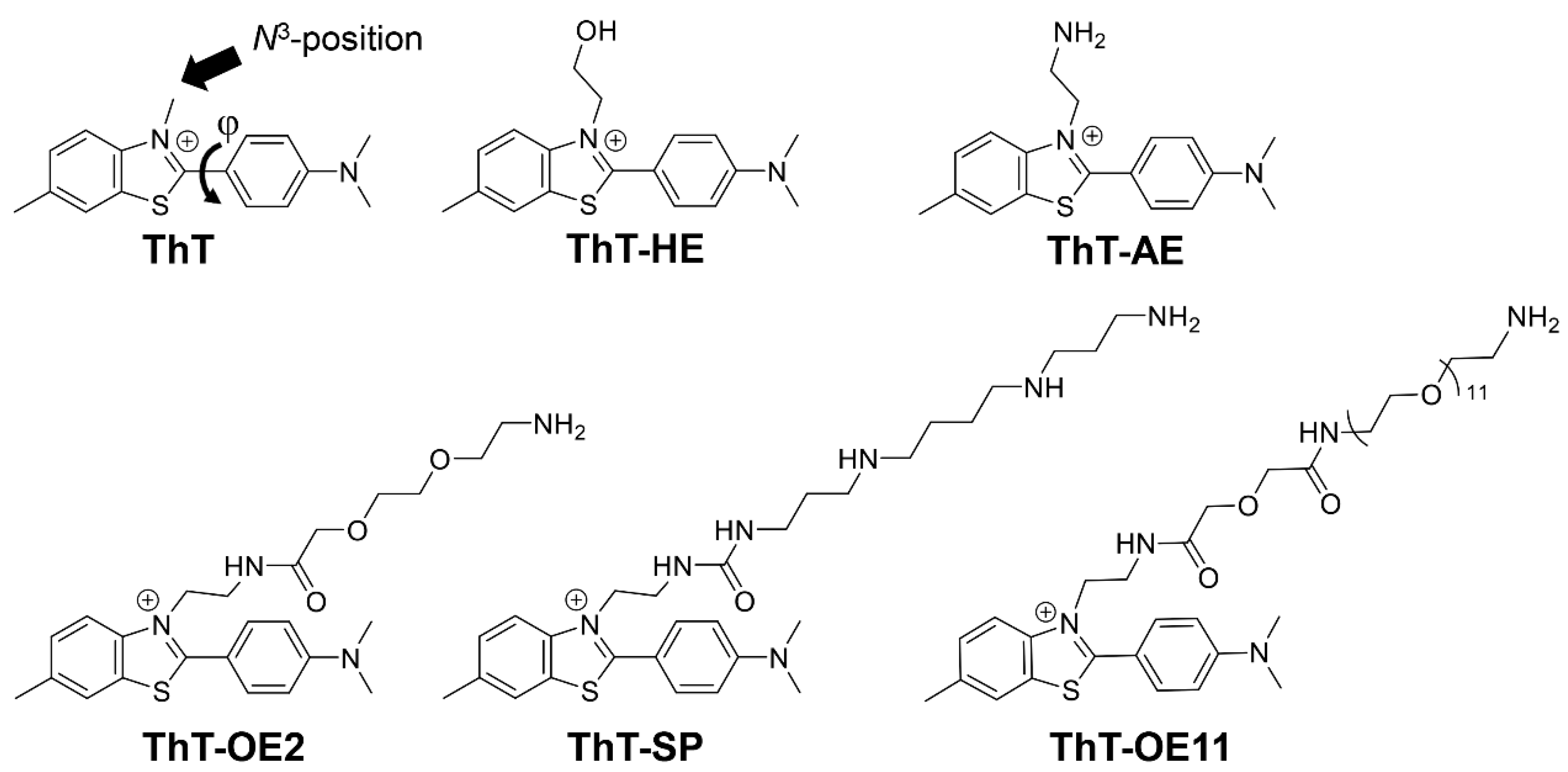
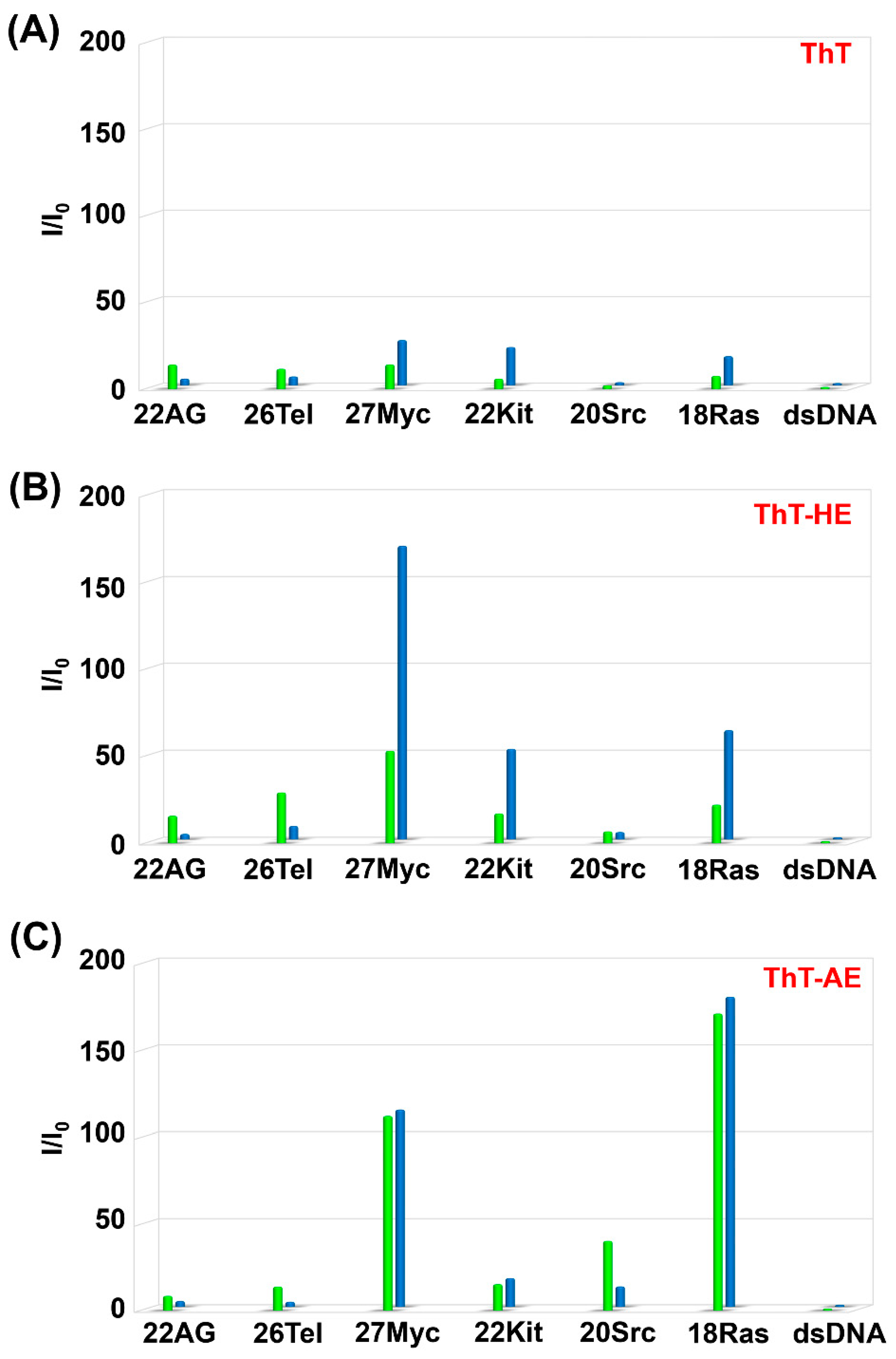
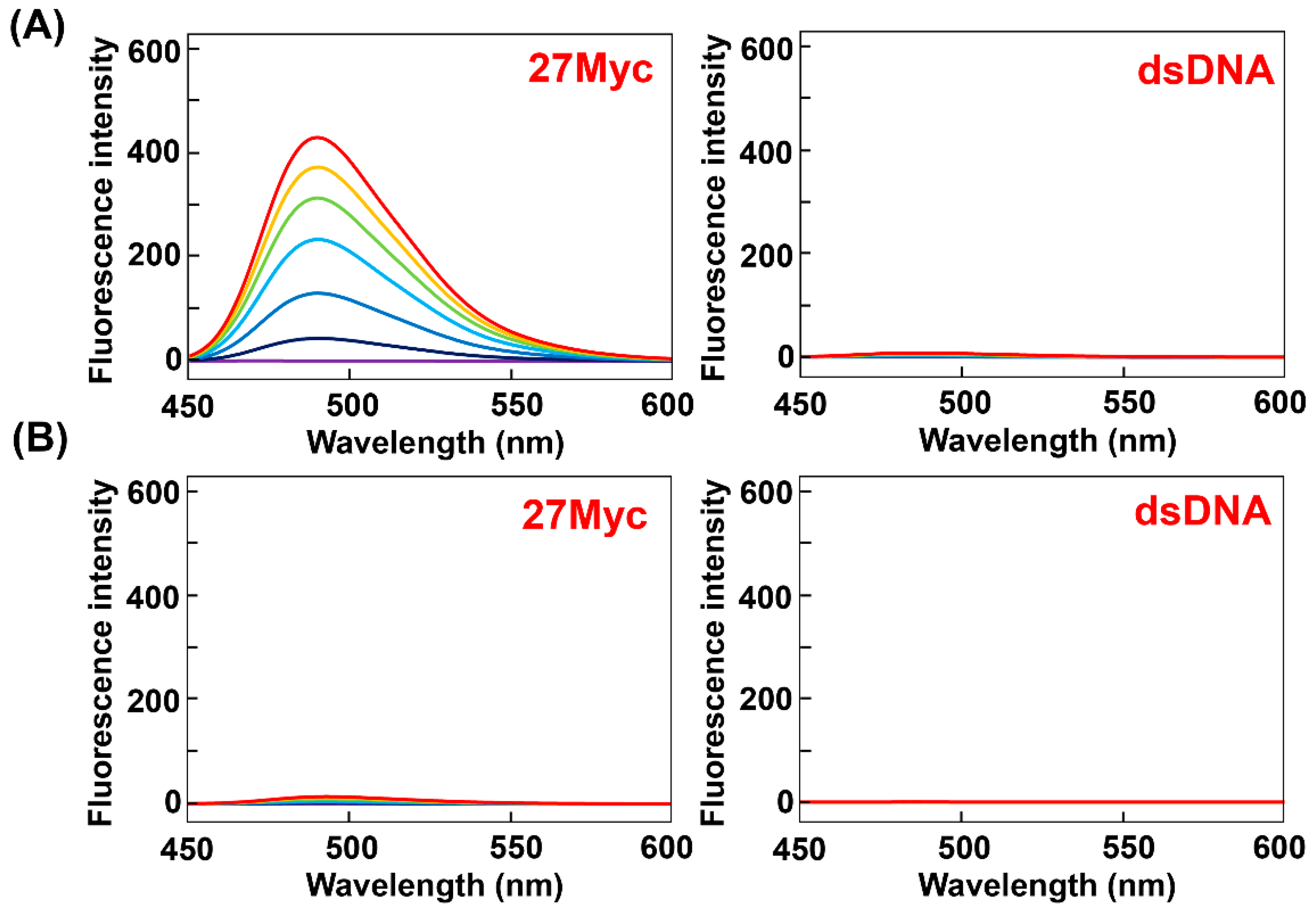
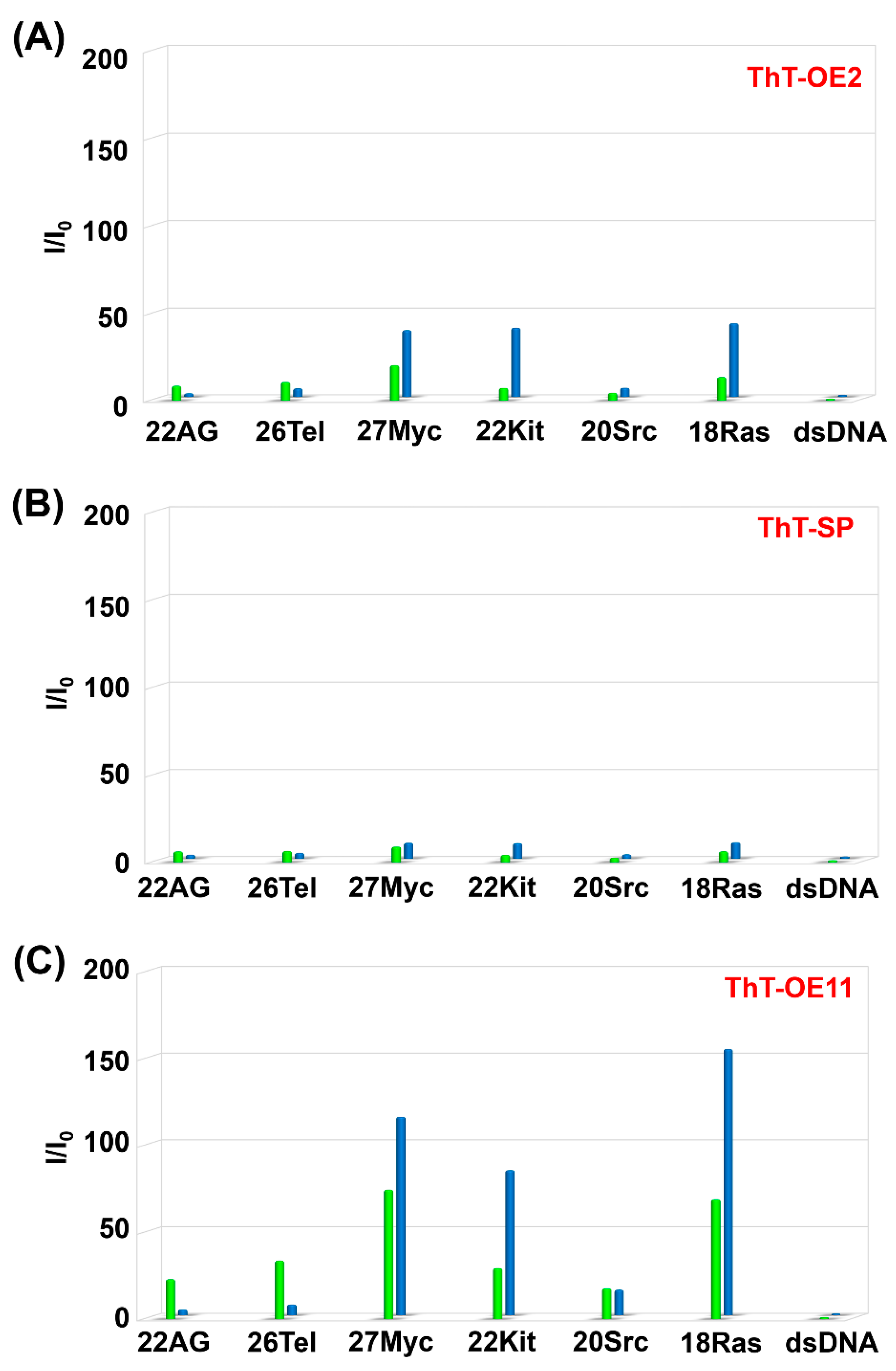
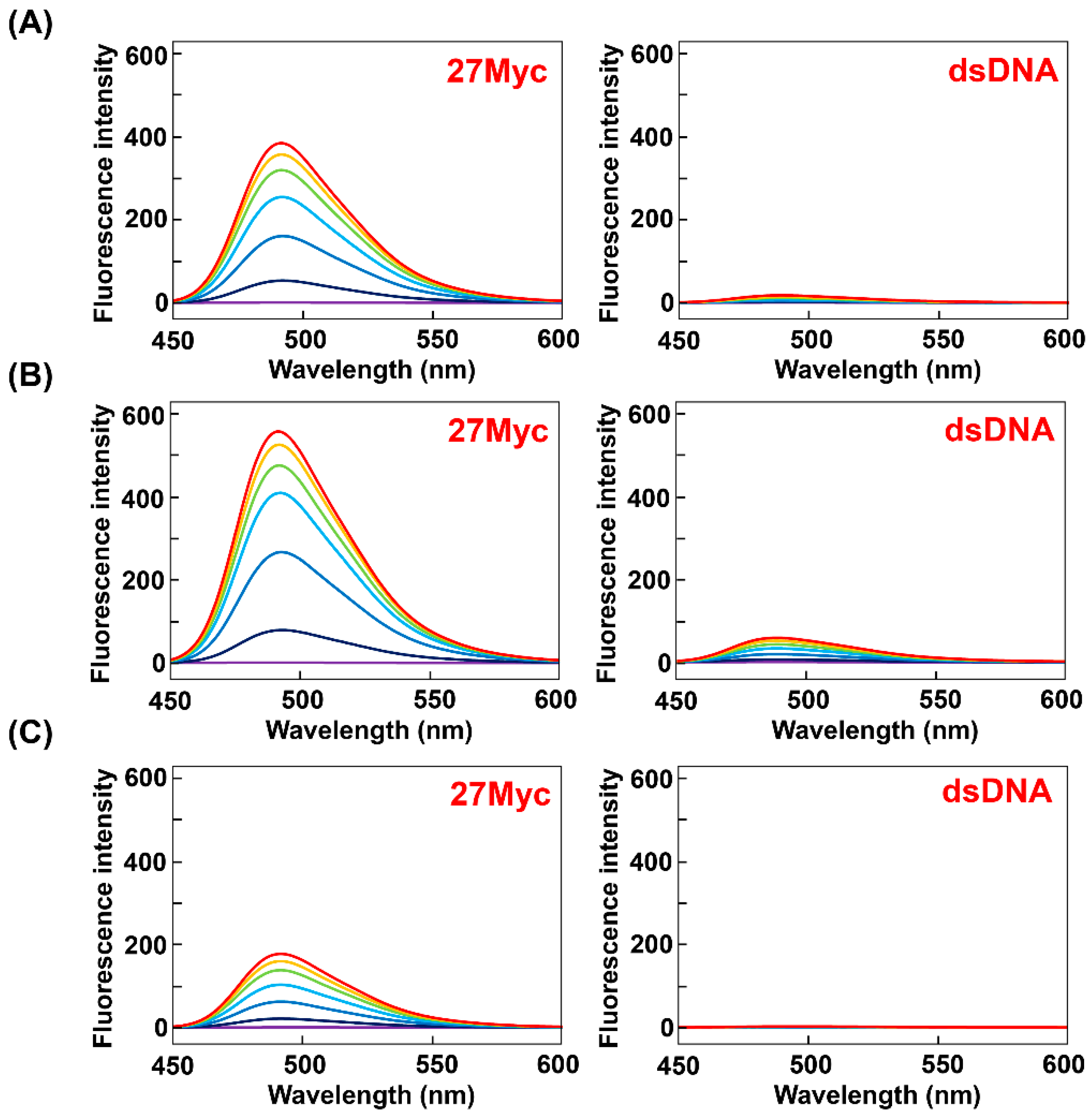

| Oligonucleotide | Sequence | Conformation | |
|---|---|---|---|
| Na+ | K+ | ||
| 22AG | 5’-AGG GTT AGG GTT AGG GTT AGG G-3’ | Antiparallel | Hybrid-1 |
| 26Tel | 5’-TTA GGG TTA GGG TTA GGG TTA GGG TT-3’ | Antiparallel | Hybrid-2 |
| 27Myc | 5’-TGG GGA GGG TGG GGA GGG TGG GGA AGG-3’ | Parallel | Parallel |
| 22Kit | 5’-AGG GAG GGC GCT GGG AGG AGG G-3’ | Parallel | Parallel |
| 20Src | 5’-GGG CGG CGG GCT GGG CGG GG-3’ | Parallel | Parallel |
| 18Ras | 5’-GGG AGG GGC GGG UCU GGG-3’ | Parallel | Parallel |
| dsDNA | 5’-GGG TTA CTA CGA ACT GG-3’ | Duplex | Duplex |
| 3’-CCC AAT GAT GCT TGA CC-5’ | |||
| Dye | Buffer | Kd (μM) a | ||||||
|---|---|---|---|---|---|---|---|---|
| Oligonucleotide | ||||||||
| 22AG | 26Tel | 27Myc | 22Kit | 20Src | 18Ras | dsDNA | ||
| ThT | PBS140KM | 5.0 ± 0.5 | 4.0 ± 0.4 | 6.9 ± 0.8 | 9.9 ± 1.2 | n.d. | 19.0 ± 2.9 | n.d. |
| PBS153NM | n.d. | 29.5 ± 5.6 | 13.5 ± 5.1 | 4.8 ± 0.8 | n.d. | 15.3 ± 1.6 | n.d. | |
| ThT-HE | PBS140KM | 20.1 ± 1.5 | 11.1 ± 1.5 | 19.9 ± 0.9 | 34.9 ± 6.6 | n.d. | 25.0 ± 3.1 | n.d. |
| PBS153NM | n.d. | n.d. | 14.1 ± 1.5 | 12.3 ± 1.8 | n.d. | 28.1 ± 4.0 | n.d. | |
| ThT-AE | PBS140KM | n.d. | 9.7 ± 5.5 | n.d. | 8.9 ± 3.5 | n.d. | n.d. | n.d. |
| PBS153NM | 23.6 ± 9.1 | n.d. | n.d. | n.d. | n.d. | n.d. | n.d. | |
| ThT-OE2 | PBS140KM | 11.8 ± 1.4 | 5.3 ± 0.4 | 8.7 ± 0.7 | 20.5 ± 1.4 | 38.6 ± 5.9 | 11.8 ± 0.6 | n.d. |
| PBS153NM | n.d. | 34.3 ± 4.0 | 10.8 ± 1.3 | n.d. | n.d. | 15.5 ± 1.7 | n.d. | |
| ThT-SP | PBS140KM | 5.4 ± 1.0 | 2.4 ± 0.4 | 6.8 ± 0.9 | 6.8 ± 0.6 | 18.8 ± 2.4 | 12.8 ± 1.9 | 16.0 ± 1.0 |
| PBS153NM | 8.2 ± 0.8 | 4.6 ± 0.3 | 5.3 ± 0.8 | 7.4 ± 3.9 | 4.1 ± 0.5 | 14.7 ± 3.2 | 9.4 ± 1.0 | |
| ThT-OE11 | PBS140KM | n.d. | 23.9 ± 3.1 | 13.4 ± 0.8 | 36.6 ± 4.4 | 20.2 ± 2.3 | 15.3 ± 1.9 | n.d. |
| PBS153NM | 20.3 ± 9.9 | n.d. | 29.1 ± 2.5 | n.d. | n.d. | 16.3 ± 1.8 | n.d. | |
Sample Availability: MSamples of the compounds are not available from the authors. | |
Publisher’s Note: MDPI stays neutral with regard to jurisdictional claims in published maps and institutional affiliations. |
© 2020 by the authors. Licensee MDPI, Basel, Switzerland. This article is an open access article distributed under the terms and conditions of the Creative Commons Attribution (CC BY) license (http://creativecommons.org/licenses/by/4.0/).
Share and Cite
Kataoka, Y.; Fujita, H.; Endoh, T.; Sugimoto, N.; Kuwahara, M. Effects of Modifying Thioflavin T at the N3-Position on Its G4 Binding and Fluorescence Emission. Molecules 2020, 25, 4936. https://doi.org/10.3390/molecules25214936
Kataoka Y, Fujita H, Endoh T, Sugimoto N, Kuwahara M. Effects of Modifying Thioflavin T at the N3-Position on Its G4 Binding and Fluorescence Emission. Molecules. 2020; 25(21):4936. https://doi.org/10.3390/molecules25214936
Chicago/Turabian StyleKataoka, Yuka, Hiroto Fujita, Tamaki Endoh, Naoki Sugimoto, and Masayasu Kuwahara. 2020. "Effects of Modifying Thioflavin T at the N3-Position on Its G4 Binding and Fluorescence Emission" Molecules 25, no. 21: 4936. https://doi.org/10.3390/molecules25214936







